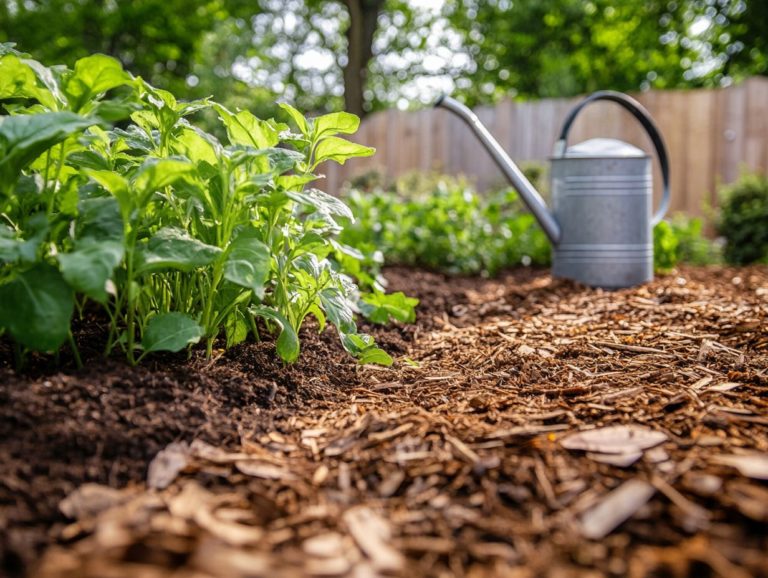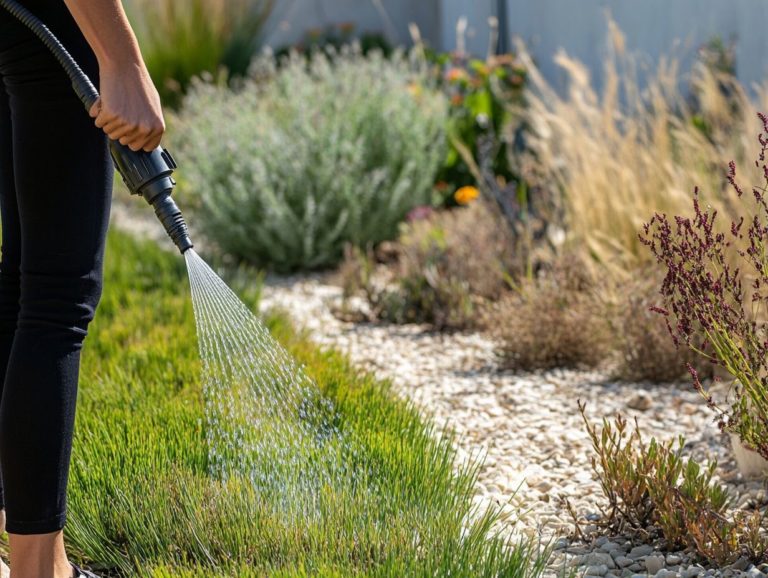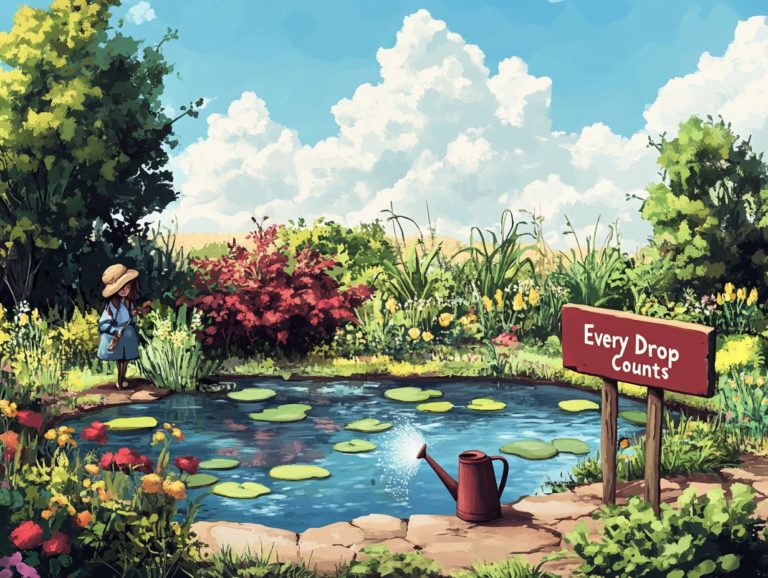Understanding the Basics of Xeriscaping
Xeriscaping goes beyond a simple gardening trend. It is a sustainable method that conserves water while creating beautiful outdoor spaces.
This article explores the essence of xeriscaping, its origins, and its many benefits, including environmental advantages and cost savings.
You ll learn how to design a xeriscape garden, receive recommendations for drought-tolerant plants, and access a step-by-step guide for implementation.
It also addresses common misconceptions, empowering you to fully embrace this eco-friendly gardening technique.
Contents
Key Takeaways:
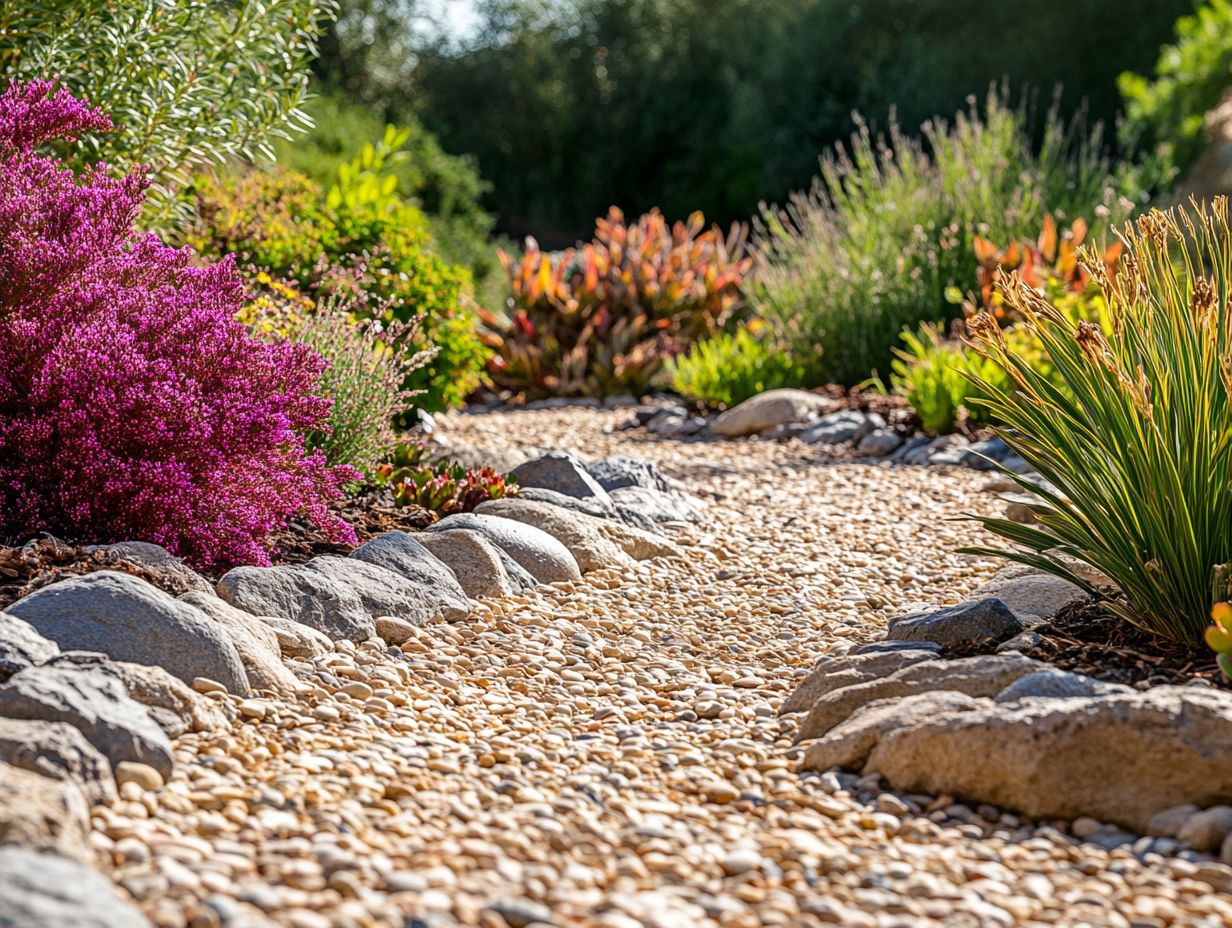
Xeriscaping focuses on conserving water and promoting sustainability. While it originated in dry areas, it can be applied anywhere.
This method offers numerous benefits, such as reduced water usage, lower maintenance costs, and environmentally friendly gardens. It also allows for creative designs.
Key elements in designing a xeriscape garden include soil type, plant selection, and efficient irrigation. Drought-tolerant plants are essential, requiring less maintenance and water.
What is Xeriscaping?
Xeriscaping is a way of landscaping that uses plants that need less water. This approach emphasizes water conservation through strategic plant selection and efficient watering systems.
This method originated in arid regions like Colorado. It uses native and drought-resistant plants to create stunning, low-maintenance gardens that thrive in tough conditions.
By enhancing soil quality and considering local ecosystems, xeriscaping not only saves water but also boosts property value and supports environmental sustainability.
Definition and Origins
The term xeriscaping comes from the Greek word ‘xeros,’ meaning dry. It describes a landscaping method designed to minimize or eliminate the need for extra water in dry climates.
This innovative approach emerged in the late 1970s due to growing concerns about water scarcity in Colorado. The region’s unique climate prompted residents to seek sustainable gardening alternatives.
Local governments and environmentalists recognized the urgent need for water conservation. By using native plants and drought-resistant techniques, they created beautiful outdoor spaces while addressing water scarcity.
Today, xeriscaping is a key part of eco-friendly practices.
Benefits of Xeriscaping
Xeriscaping offers many advantages, from saving water to reducing bills, all while increasing your property s value.
By adopting this approach, you can create a low-maintenance landscape with drought-resistant plants. This positive impact benefits both your finances and the environment.
Environmental and Cost Savings
The environmental and financial benefits of xeriscaping are substantial. This method can lead to lower water bills while promoting sustainable practices that protect local ecosystems.
Choosing drought-resistant plants and smart watering methods creates a landscape that thrives with minimal upkeep.
For instance, using native species lets you skip chemical fertilizers and pesticides, resulting in healthier soil and better biodiversity. This low-maintenance approach reduces gardening costs over time, allowing you to invest those savings in other home improvements.
With a vibrant range of plants supporting pollinators and wildlife, your gardening efforts contribute significantly to environmental sustainability, fostering a greener community for future generations.
Designing a Xeriscape Garden
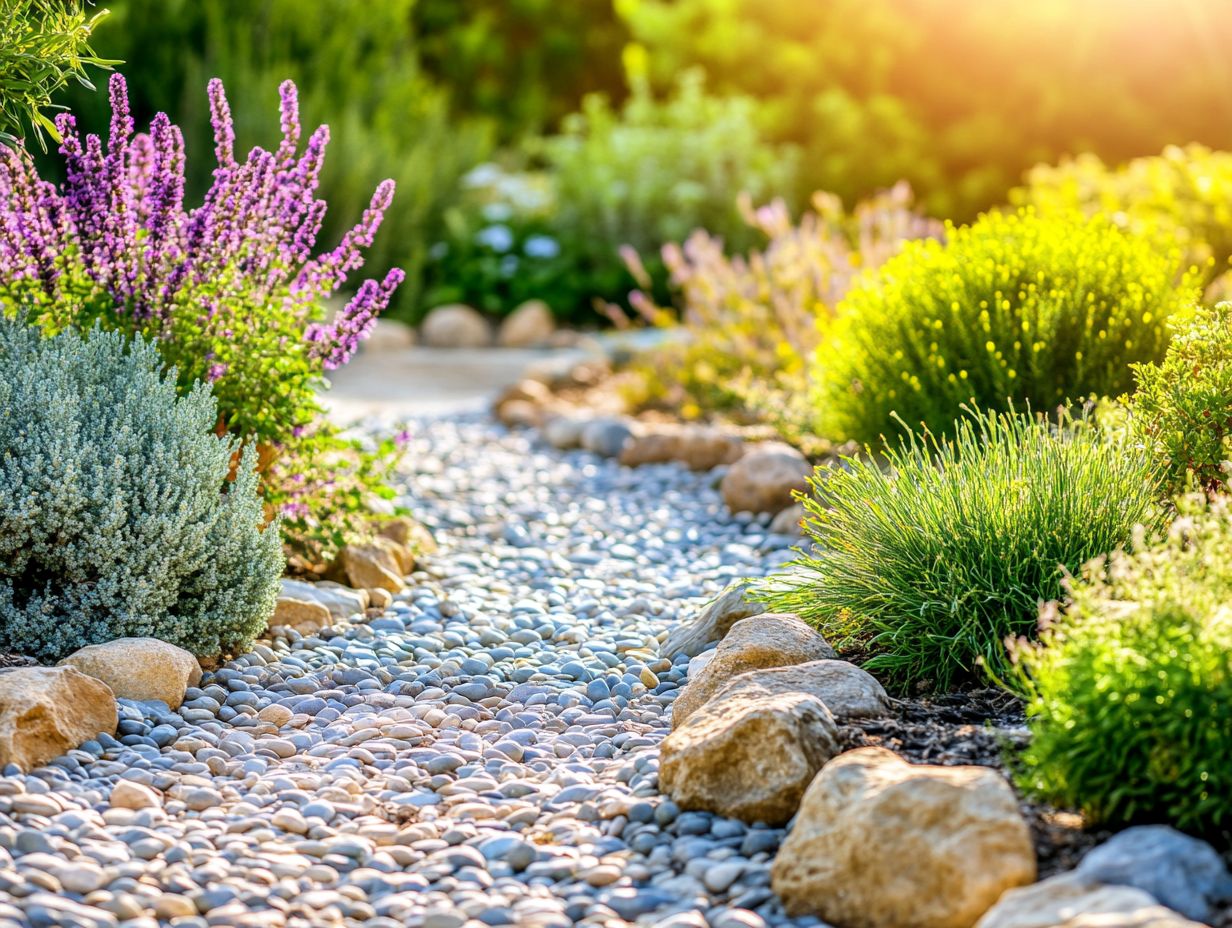
Designing a Xeriscape garden means embracing landscape design principles that prioritize efficient irrigation methods and incorporate drought-tolerant plants. This approach creates a beautiful, sustainable outdoor space.
Employing companion planting techniques boosts biodiversity and supports local ecosystems. This ensures your garden flourishes with minimal maintenance.
Key Elements and Considerations
When designing a Xeriscape garden, keep key elements and considerations in mind. Start by selecting native plants, incorporating ornamental grasses, and implementing efficient irrigation systems to maximize every precious drop of water.
Improving soil conditions is essential in sustainable landscaping. Techniques like adding organic matter significantly enhance soil structure and moisture retention, benefiting your plants’ health.
Emphasizing deep-root planting methods allows your plants to tap into underground moisture sources, reducing their reliance on surface watering. Don t overlook the power of mulch; it suppresses weed growth, maintains soil temperature, and minimizes evaporation rates.
By combining these elements, your Xeriscape garden transforms into a thriving ecosystem. It showcases the beauty and resilience of the landscape while promoting environmental stewardship.
Plants for Xeriscaping
Selecting the right plants is vital for Xeriscaping success. Focus on choosing drought-tolerant and drought-resistant species that thrive in your local climate, such as agave and lavender.
These native plants demand less water and contribute to biodiversity, creating habitats for wildlife. Choosing them sets the stage for a sustainable landscape that flourishes even in drought-prone areas.
Drought-Tolerant Species and Maintenance
Drought-tolerant species are essential to Xeriscaping. They require minimal water and maintenance while enhancing your garden’s overall health. Incorporating native plants and organic mulch cultivates a self-sustaining ecosystem that flourishes with little intervention.
These plants elevate the aesthetic appeal of your landscape and provide vital support for local wildlife, offering habitats and food sources for pollinators and beneficial insects.
Including species like lavender, succulents, and various ornamental grasses decreases reliance on chemical fertilizers, as these plants are naturally suited to local soil conditions.
Utilizing organic mulch helps retain moisture, regulate soil temperature, and suppress weeds. Embrace these ecological practices to enjoy a vibrant, low-maintenance space that enriches both your environment and lifestyle.
Implementing Xeriscaping Techniques
Implementing Xeriscaping techniques requires a thoughtful, step-by-step approach. Emphasize effective watering methods, such as drip irrigation, which waters plants directly at their roots, minimizing water loss. Also, apply organic mulch to improve soil quality and retain moisture.
By embracing these strategies, cultivate a vibrant landscape that conserves water while enhancing your garden’s overall health.
Step-by-Step Guide
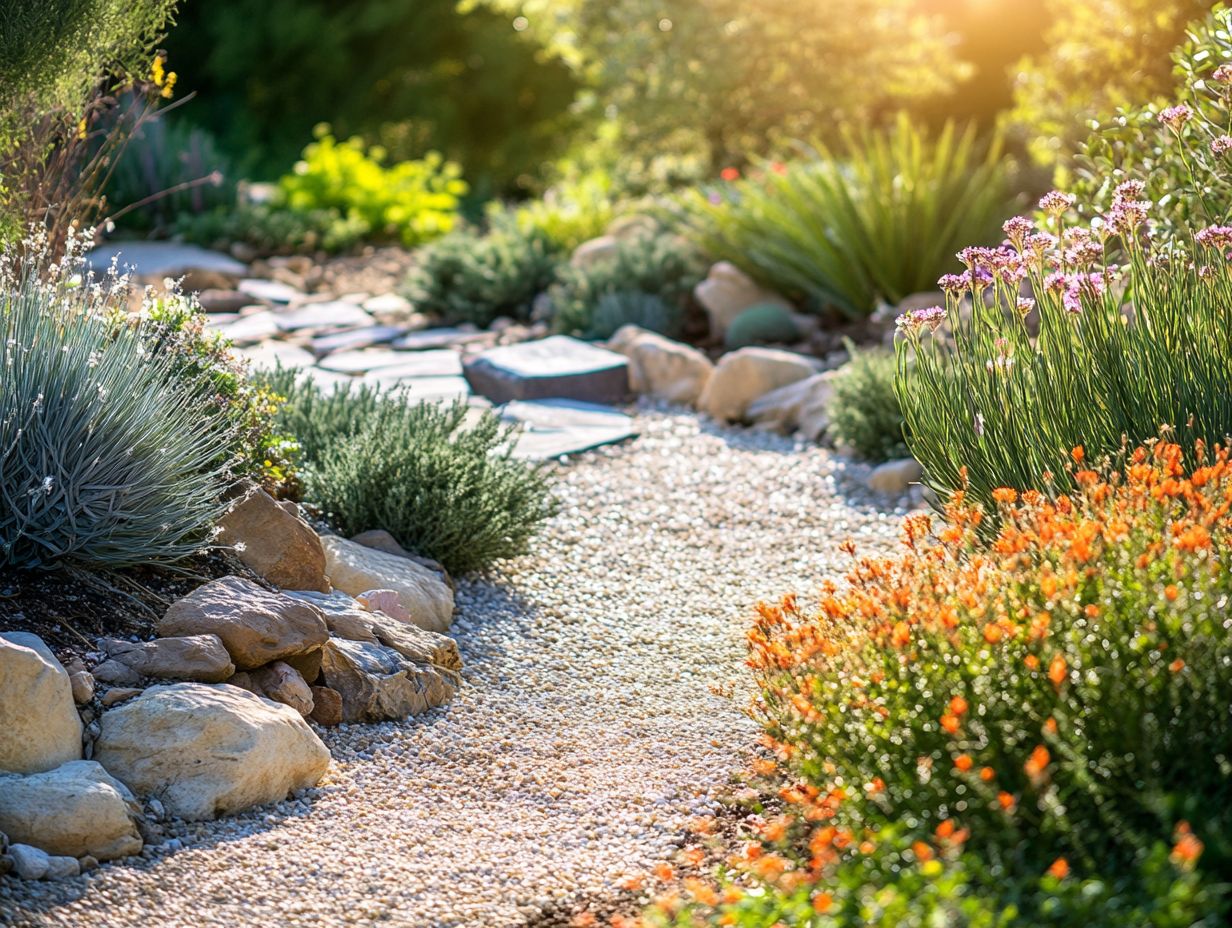
A step-by-step guide to implementing Xeriscaping starts with assessing your landscape, selecting the right drought-resistant plants, and planning an efficient irrigation system to optimize water usage.
After analyzing your outdoor space, choose plants that thrive in dry conditions and enhance your garden’s aesthetic.
Next, design the layout of your irrigation system for efficient water distribution. Emphasizing drip irrigation drastically cuts down on waste, ensuring water reaches the roots where it’s needed most.
Incorporating organic mulch around your plants conserves moisture, suppresses weeds, and enhances soil health.
Follow these strategic steps to create a sustainable, thriving landscape that requires minimal resources over time!
Common Misconceptions About Xeriscaping
There are a number of misconceptions surrounding Xeriscaping, including the notion that it results in a barren landscape or demands excessive maintenance. These beliefs can often discourage homeowners from adopting this environmentally sustainable practice.
However, the truth is quite different: Xeriscaping focuses on utilizing drought-tolerant plants, fostering vibrant habitats that support wildlife while requiring minimal upkeep once established. Embracing Xeriscaping can transform your outdoor space into a flourishing, low-maintenance oasis.
Debunking Myths and Addressing Concerns
Debunking myths about Xeriscaping is crucial to address any lingering concerns regarding its aesthetic appeal and maintenance requirements. Many believe it results in dull, lifeless landscapes, but that couldn’t be further from the truth.
In reality, Xeriscaping can transform your outdoor spaces into vibrant ecosystems, showcasing a diverse array of colors and textures. By incorporating native plants, creative hardscaping (referring to non-plant elements like paths and patios), and thoughtful design elements, you can craft gardens that are visually striking and functionally sustainable.
Utilizing mulch, rocks, and drought-tolerant flora adds depth while significantly cutting down on water consumption. Maintenance tips like applying mulch and regular pruning will enhance your garden’s beauty, ensuring it remains a captivating refuge that harmonizes with its surroundings.
This approach respects ecological balance and invites more wildlife, enriching your garden experience in ways you never thought possible.
Frequently Asked Questions
What is xeriscaping?
Xeriscaping is a landscaping technique that creates a low-water and sustainable garden or outdoor space. It involves using drought-resistant plants, efficient irrigation systems, and other water-saving methods to conserve water and reduce maintenance costs.
Why is xeriscaping becoming more popular?
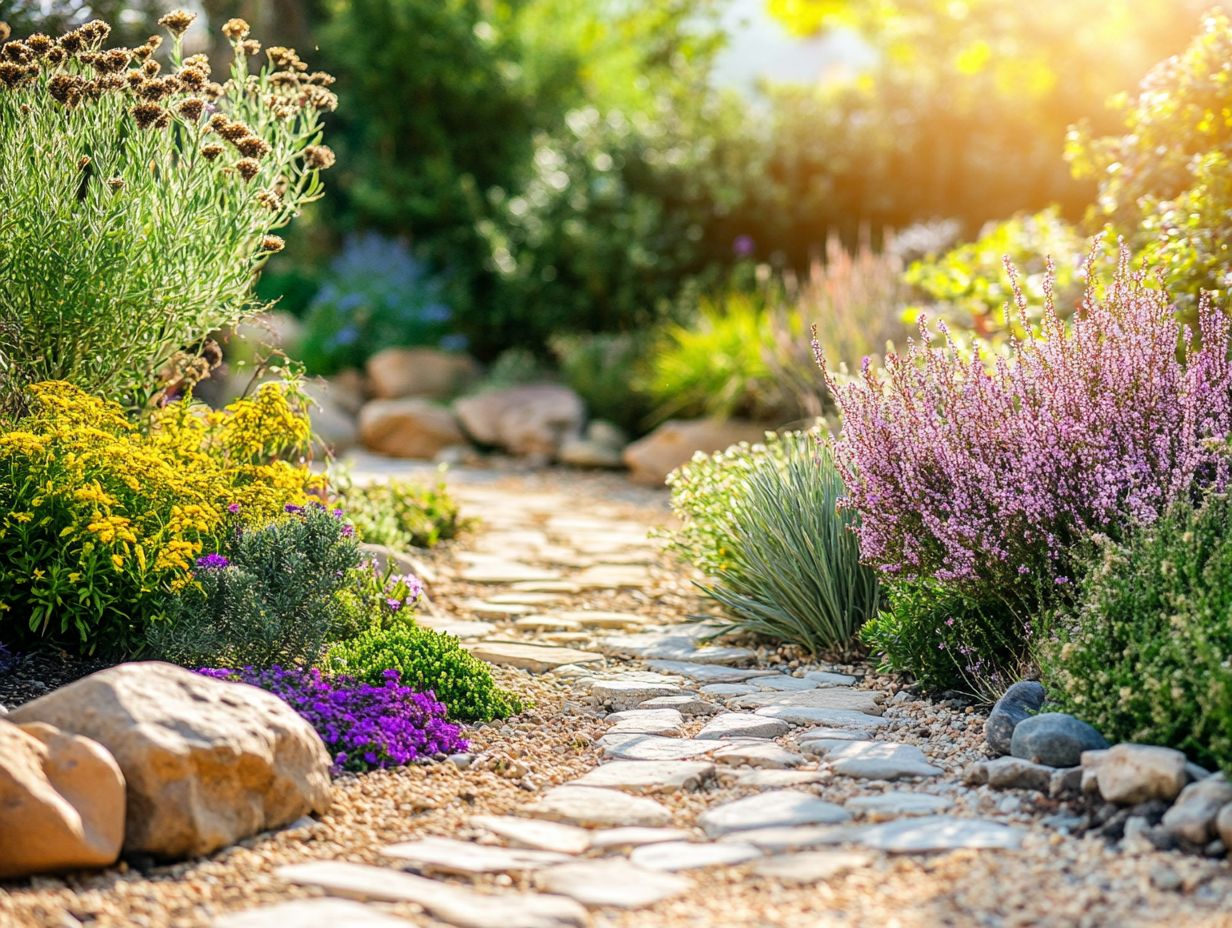
Xeriscaping is gaining popularity due to its numerous benefits, such as reduced water usage and lower maintenance costs. It also helps conserve natural resources and supports a healthier environment. Xeriscaping also adds aesthetic value to a property and increases its curb appeal.
Do I have to live in a dry climate to xeriscape?
No, xeriscaping can be implemented in any climate, including areas with high rainfall. Xeriscaping aims to create a water-efficient landscape, achievable by using drought-resistant plants and implementing water-saving techniques like mulching and proper irrigation.
What are the key principles of xeriscaping?
The key principles of xeriscaping include planning and design, soil improvement, appropriate plant selection, efficient irrigation, use of mulch, and proper maintenance. These principles work together to create a sustainable and low-water landscape.
Can I still have a beautiful garden with xeriscaping?
Absolutely! Xeriscaping does not mean sacrificing a beautiful garden. In fact, it can enhance the aesthetic appeal of a garden by incorporating various textures, colors, and shapes of drought-resistant plants. With proper planning and design, a xeriscape garden can be both sustainable and visually appealing.
Is xeriscaping expensive to implement?
While the initial cost of xeriscaping may be slightly higher than traditional landscaping, you’ll save money over time. By reducing water usage and maintenance costs, xeriscaping helps homeowners and businesses save on their water bills and landscaping expenses. Moreover, it can increase property value and reduce the need for constant lawn care.
Start your Xeriscaping journey today and discover the beauty of a sustainable garden!



